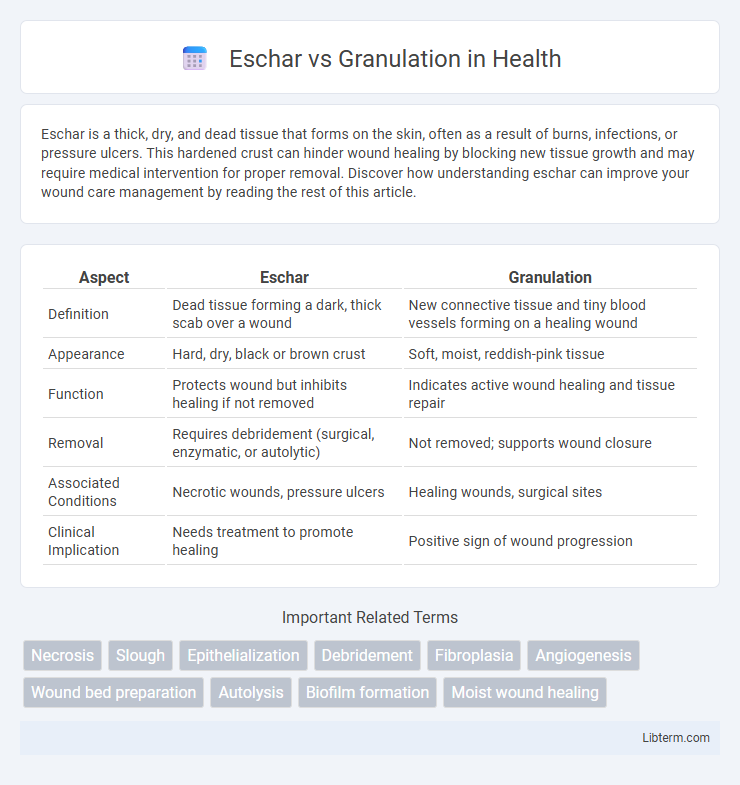Eschar is a thick, dry, and dead tissue that forms on the skin, often as a result of burns, infections, or pressure ulcers. This hardened crust can hinder wound healing by blocking new tissue growth and may require medical intervention for proper removal. Discover how understanding eschar can improve your wound care management by reading the rest of this article.
Table of Comparison
| Aspect | Eschar | Granulation |
|---|---|---|
| Definition | Dead tissue forming a dark, thick scab over a wound | New connective tissue and tiny blood vessels forming on a healing wound |
| Appearance | Hard, dry, black or brown crust | Soft, moist, reddish-pink tissue |
| Function | Protects wound but inhibits healing if not removed | Indicates active wound healing and tissue repair |
| Removal | Requires debridement (surgical, enzymatic, or autolytic) | Not removed; supports wound closure |
| Associated Conditions | Necrotic wounds, pressure ulcers | Healing wounds, surgical sites |
| Clinical Implication | Needs treatment to promote healing | Positive sign of wound progression |
Understanding Eschar and Granulation: Key Differences
Eschar is a tough, dry, and necrotic tissue that forms a dark crust over wounds, typically indicating dead skin that hinders the healing process. Granulation tissue, by contrast, consists of new, healthy connective tissue and microscopic blood vessels that develop on the wound bed during healing, signaling active tissue regeneration. Recognizing the presence of eschar versus granulation is crucial for effective wound management, as eschar often requires debridement while granulation indicates progression toward wound closure.
Definition and Characteristics of Eschar
Eschar is a thick, dry, and leathery necrotic tissue that commonly forms over a wound, characterized by its dark brown or black color resulting from dead skin cells and debris. It typically appears firmly adhered to the underlying tissue and acts as a natural barrier but impedes wound healing by blocking new tissue growth. Unlike granulation tissue, which is pink or red, moist, and indicates active healing, eschar must often be removed to allow for effective wound repair and regeneration.
Definition and Features of Granulation Tissue
Granulation tissue is newly formed connective tissue that appears during the wound healing process, characterized by a red, bumpy surface composed of proliferating fibroblasts, new capillaries, and extracellular matrix. It plays a crucial role in filling wound cavities and serves as a foundation for epithelial cell migration. Unlike eschar, which is a dry, thick, necrotic scab or dead tissue, granulation tissue indicates active tissue repair and a healthy healing environment.
Causes and Formation of Eschar in Wounds
Eschar forms as a thick, leathery layer of dead tissue resulting from ischemia, infection, or prolonged pressure that leads to necrosis in wounds. It consists primarily of dried fibrin, dead cells, and coagulated proteins that adhere firmly to the underlying tissue, impeding normal healing. Granulation tissue, by contrast, develops after eschar removal, characterized by new capillaries and fibroblasts promoting wound repair and re-epithelialization.
How Granulation Tissue Develops in Healing
Granulation tissue develops during the proliferative phase of wound healing as new connective tissue and microscopic blood vessels form on the wound surface. Fibroblasts migrate into the wound area, producing collagen and extracellular matrix, which provide structural support for tissue repair. This reddish, bumpy tissue replaces eschar, signaling progression from necrotic tissue toward wound closure and regeneration.
Clinical Significance: Eschar vs Granulation Tissue
Eschar represents necrotic, dead tissue that acts as a barrier to wound healing and increases the risk of infection, requiring debridement for proper management. Granulation tissue is a sign of active healing characterized by new capillary growth and fibroblast proliferation, indicating wound progression towards closure. Differentiating eschar from granulation tissue is critical in clinical decision-making to optimize wound care and promote recovery.
Visual Identification: Eschar and Granulation Comparison
Eschar appears as dry, dark, thick necrotic tissue often black or brown in color, forming a hard scab that is firmly attached to the wound bed. Granulation tissue is characterized by its moist, red or pink appearance with a bumpy texture, indicating healthy new tissue and active healing. Differentiating between eschar and granulation visually is critical for wound management, as eschar may require debridement while granulation signifies positive progress toward wound closure.
Implications for Wound Management and Treatment
Eschar, characterized by dry, necrotic tissue, acts as a barrier to wound healing and often requires debridement to prevent infection and promote granulation. Granulation tissue, composed of new connective tissue and capillaries, signifies active healing and is essential for wound closure. Effective wound management prioritizes eschar removal to facilitate granulation development, optimize moisture balance, and promote tissue regeneration.
Potential Complications: Eschar and Granulation Issues
Eschar, a thick, necrotic tissue, can cause complications such as infection, delayed wound healing, and increased risk of sepsis if not properly managed. Granulation tissue, while essential for healing, may lead to problems like hypergranulation, which can impede epithelialization and increase bleeding risk. Both eschar and abnormal granulation require careful assessment to prevent chronic wounds and promote effective tissue repair.
Eschar and Granulation: Prognosis and Recovery Outcomes
Eschar, a dry, dark necrotic tissue, often indicates severe tissue damage and can hinder wound healing by blocking new tissue growth. Granulation tissue, characterized by new connective tissue and microscopic blood vessels, signifies active healing and a positive prognosis for wound recovery. Effective removal of eschar promotes granulation, leading to faster wound closure and improved overall recovery outcomes.
Eschar Infographic

 libterm.com
libterm.com